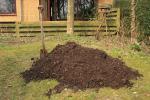COLUMBIA, Mo. – Grain farmers should use caution on how they apply recently released data on crop productivity related to drought, said University of Missouri Extension agronomy specialist Bill Wiebold. “Don’t make drastic changes in your operation based upon one year’s experience,” he warns.
Wiebold will speak on crop management techniques that may add stability to corn and soybean yields in 2013 at the MU Crop Management Conference, Dec. 18-19 at the Holiday Inn Executive Center in Columbia.
Wiebold has published his analysis of U.S. Department of Agriculture (USDA) data in recent MU Integrated Pest Management publications (ipm.missouri.edu/ipcm). Crop productivity is a good indicator of drought intensity. “Drought severity, as calculated by corn yield loss, was greater in 2012 than for any year within the past 50 years,” he said.
Early data indicates that corn and soybean yields were well below trend lines. Final numbers from USDA National Agricultural Statistics Service likely won’t be available until early 2013.
Reports are coming in that Missouri soybean yields may be greater than USDA predictions of 28 bushels per acre in September, 28 percent below the trend line yield, Wiebold said. Higher numbers may be due to rains from Hurricane Isaac in late August. “It just shows how resilient soybeans are,” he said. Late-maturing varieties were helped more by Isaac than other varieties. Wiebold’s research shows the greatest soybean yield loss from drought came in 1983, 1984 and 2012.
In September, USDA predicted corn yields would be 75 bushels per acre, 46 percent below a trend line yield Wiebold has calculated since 1963. While many farmers compared the 2012 drought to that of 1988, predicted yield loss for 2012 is double that of 1988. Additionally, 1988’s yield losses were located primarily in the northern third of the state.
USDA reports that 89 percent of all soybeans and 100 percent of the corn crop has been harvested in Missouri. County averages can be seen at www.nass.usda.gov.
Corn and beans respond differently to drought due to the different pollination periods. Corn has a 10-day period, and temperatures above 100 degrees hit when much of Missouri’s corn crop was pollinating and silking. Stress on plants at this stage reduced the number of fertilized flowers, and stress after silking resulted in increased kernel abortion or reduced seed size.
By contrast, soybeans have a 30-day period and a “built-in reserve capacity” that can make internal modifications to stress during pod development. Stress at this time reduces the number of flowers and small pods that remain on the stalk. Stress during seed filling can result in additional pod abscission, arrested development of seeds in retained pods and reduced seed size.
Wiebold said he would caution farmers at the conference against drastic changes in 2013. He also will show updated graphics on yield variability throughout the state. He will urge farmers to diversify their crops and reevaluate their seeding rates based upon soil conditions in their area, rather than across the varied geographical areas of the state. “Understanding where you’re farming is important,” he said. “What is the water supply where you live? What are the typical weather patterns where you live?”
Wiebold will present information from MU’s 19 corn and 20 soybean plots across the state. “We had fields that yielded nothing and others, especially on the Mississippi and Missouri rivers, that did particularly well,” he said.
A full schedule of the Crop Management Conference, sponsored by the Division of Plant Sciences, MU College of Food and Natural Resources, is available at plantsci.missouri.edu/cmc/.
Read more http://extension.missouri.edu/news/DisplayStory.aspx?N=1608






